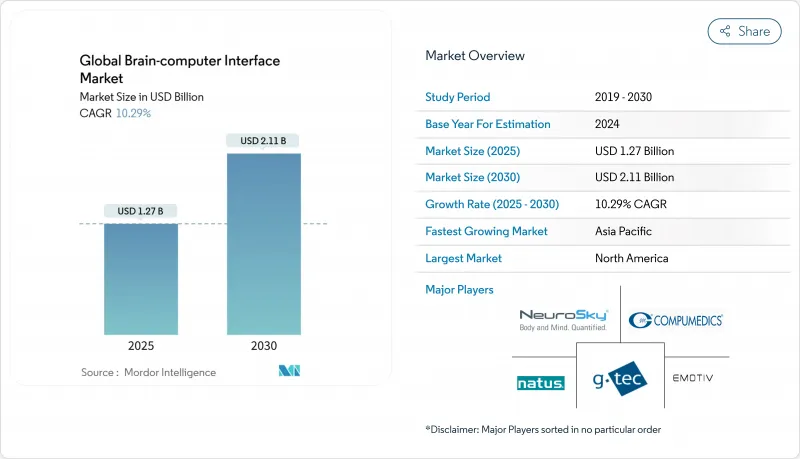
|
市場調査レポート
商品コード
1852205
ブレインコンピュータインターフェース:市場シェア分析、産業動向、統計、成長予測(2025年~2030年)Brain-computer Interface - Market Share Analysis, Industry Trends & Statistics, Growth Forecasts (2025 - 2030) |
||||||
カスタマイズ可能
適宜更新あり
|
|||||||
| ブレインコンピュータインターフェース:市場シェア分析、産業動向、統計、成長予測(2025年~2030年) |
|
出版日: 2025年09月23日
発行: Mordor Intelligence
ページ情報: 英文 152 Pages
納期: 2~3営業日
|
概要
ブレインコンピュータインターフェースの世界市場規模は2025年に12億7,000万米ドルと推定され、予測期間(2025-2030年)のCAGRは10.29%で、2030年には21億1,000万米ドルに達すると予測されます。

資本流入、成熟しつつあるハードウェア・プラットフォーム、ニューラル・デコーディングと高度な人工知能の組み合わせが、この拡大を支える主な力となっています。ベンチャー企業による資金調達は商業化のタイムラインを短縮し続け、病院は埋め込み型ソリューションの早期採用を加速し、消費者向けヘッドセットはゲーム、福祉、人間と機械の共生へとブレインコンピュータインターフェース市場の範囲を広げています。ハイブリッド信号アーキテクチャとソフトウェア定義機能が製品の差別化をさらに後押しし、政府資金による臨床試験が安全性と倫理の基準を押し進める。需要面では、神経変性疾患の有病率の上昇とコミュニケーション支援ツールへの期待の高まりが、臨床ユーザーを収益創出の中核に据えています。
世界のブレインコンピュータインターフェース市場動向と洞察
コミュニケーション支援技術に対する需要の急増
米国国立衛生研究所(National Institutes of Health)が支援する調査により、麻痺患者の明瞭な発話が99%の単語レベルの精度で回復した[2]。その後、シンクロンはステントロード・インプラントとジェネレーティブAIモデルを組み合わせ、さらに多くのユーザーにハンズフリーのテキスト入力を可能にしました。病院は、介護サイクルの短縮と患者の自律性スコアの向上を報告しており、ALSだけでなく、外傷性脊髄損傷や脳幹卒中(ユーザーデータ)へと臨床的対処可能プールを拡大しています。米国の民間保険会社は、音声デコードインプラントに対する初期の償還事例を検討し始めており、耐久性のあるQOLの向上に対する支払者の認識が高まっていることを示しています。欧州の教育病院では現在、集学的な神経リハビリテーション・プログラムに言語モデル強化BCIを組み込んでおり、地域全体で中期的な採用が強化されています。
EEGベースのウェアラブルヘッドセットの急速な普及
ゲームスタジオ、eスポーツ主催者、消費者向けウェルネス・ブランドは、ドライ電極ヘッドセットをインタラクティブ・タイトル、フィットネス・プログラム、瞑想プラットフォームに統合しています。ストリーマーは神経入力によるフルゲームプレイの制御を実証し、競合リーグは集中力と感情状態のデータをコーチングのために試しています。これらの導入は、低遅延信号抽出のアルゴリズムを研ぎ澄まし、小型化を加速させ、医療関係者以外の聴衆に脳とコンピュータの相互作用の日常的な利点を教育します。出荷台数が増えれば、規模の経済によって単価が下がり始め、ベンダーはサブスクリプションベースの分析をバンドルして、ユーザー1人当たりの収益を増やすことができるようになります。
手術リスクと規制上のハードル
植え込み型システムは優れた信号忠実度を提供するが、頭蓋や血管の手術を伴うため、実施できるセンターは限られます。電極の移動、感染、デバイスの回収に関する報告は、臨床医や保険者の間に警戒心を抱かせる。規制機関は長時間の安全性監視を要求し、市場投入までの時間を引き延ばし、試験予算を膨れ上がらせています。このような障害により、初期の採用は資金力のある大学病院や裕福な自己負担患者に限られ、幅広い普及が遅れています。ベンダーは、ステントのような送達ツールを改良し、可逆性インプラントを開発することで対応しているが、それでも数年にわたる承認経路をナビゲートしなければならないです。
セグメント分析
非侵襲性ヘッドセットと電極アレイは2024年の売上高の76.50%を占め、ブレインコンピュータインターフェース市場において多くの開発者にとってのエントリーポイントとしての役割を明確にしました。ドライ電極と低エネルギーBluetoothを搭載した製品の発売により、セットアップ時間が短縮され、快適性が向上し、仮想現実ゲームや遠隔ニューロフィードバックなどの日常的な使用シナリオが可能になりました。病院は手術リスクの回避を評価し、消費者ブランドは規制のハードルの低さを活用して、棚への配置を加速しています。競合の激化にもかかわらず、価格低下とS/N比の改善が2桁成長を支え続けています。
ソフトウェアとアルゴリズム層はCAGR 12.10%で拡大しており、このペースはハードウェアを上回っています。トランスフォーマーベースのデコーダー、トランスファー学習、自己較正フレームワークは、情報伝達率を3桁上昇させる。これらの進歩は、2030年までに19億米ドルから51億米ドルに増加すると予測される、新たなSaaSサブセグメントを生み出します。サービスプロバイダーは、社内に専門家を持たない臨床バイヤーに、クラウドダッシュボード、電気保守契約、コンプライアンス監査を提供します。これらの活動は、ベンダーを純粋なハードウェアの利益圧縮から守る、バランスの取れた収益ミックスを維持します。
モーター/出力プラットフォームは、2024年の支出の50.90%を占め、麻痺患者のカーソル操作、車椅子ナビゲーション、義肢操作の回復に関する臨床優先事項を反映しています。秒以下の応答速度が可能な非侵襲的ディープラーニング・デコーダの実証実験が成功し、集中治療室以外への訴求が広がりました。消費者向け開発者は、これらのブレークスルーを拡張現実ヘッドセットやスマートホームデバイスのジェスチャーレス入力に適応させ、この分野の成熟を強化しています。
EEG、筋電図、機能的近赤外分光法、または集束超音波を組み合わせたハイブリッドアーキテクチャは、CAGR 13.56%の勢いです。複数の神経信号と末梢信号を融合させることで信頼性を高め、単一モダリティ・システムの障害となるアーチファクトを補正します。脳卒中リハビリの実験装置では、脳と筋肉のハイブリッド・トレーニングを2週間行った後、患者の83%が測定可能な手の機能を取り戻しました。部品コストが下がるにつれて、ハイブリッド回路は実験室からモジュール式の消費者向けアクセサリーに移行すると思われます。
地域分析
北米は2024年の売上高の48.54%を占め、依然としてブレインコンピュータインターフェース市場の中心です。米国国立衛生研究所(National Institutes of Health)の資金、豊富なベンチャープール、専門的な手術チームが、音声解読、双方向感覚、うつ病の神経調節に及ぶ継続的な試験パイプラインを支えています。この地域は、診療報酬試験を臨床ワークフローに統合し、支払者の受け入れを加速する早期導入医療システムの恩恵を受けています。個人情報保護法は急速に進化しており、安全なデータアーキテクチャに早期に投資する企業にとって、コンプライアンス上のオーバーヘッドと競争上の優位性の両方を生み出しています。
アジア太平洋地域のCAGRは最速の12.56%であり、これは中国政府がブレイン・マシン・インターフェイスを戦略的産業として指定したことが後押ししています。国からの補助金が産学コンソーシアムを後押しする一方、新たな標準化団体が信号取得プロトコルや倫理ガイドラインに取り組んでいます。中国の新興企業はすでに北京語の音声解読で71%の精度を実証しており、この地域の勢いを強調しています。日本の高齢化社会は、神経変性疾患の管理という構造的な需要ドライバーを追加し、韓国の電子機器メジャーはセンサーの小型化に関する専門知識を提供します。
欧州では、公的医療制度が気分向上試験や脳卒中回復プログラムに資金を提供しており、大きなシェアを占めています。国民保健サービス(National Health Service)による650万英ポンドの超音波ベースのBCI試験は、メンタルヘルス状態に対する非医薬品的アプローチに対する政策レベルのコミットメントを強化するものです。間もなく施行されるEUのAI法では、多くのAI対応医療機器が高リスクに分類されるため、ベンダーは他地域での競合差別化要因となりうる厳格なサイバーセキュリティと性能検証手順の採用を余儀なくされます。中東・アフリカ、南米では、モバイル接続と国境を越えたトレーニング・パートナーシップを活用して、遠隔リハビリテーションと遠隔神経モニタリングに投資しています。
その他の特典:
- エクセル形式の市場予測(ME)シート
- 3ヶ月間のアナリストサポート
よくあるご質問
目次
第1章 イントロダクション
- 調査の前提条件と市場の定義
- 調査範囲
第2章 調査手法
第3章 エグゼクティブサマリー
第4章 市場情勢
- 市場概要
- 市場促進要因
- EEGベースのウェアラブルヘッドセットのeスポーツおよびゲーム企業による急速な採用
- 神経技術の中心地(シリコンバレー、ローザンヌ、ウィーン)におけるVCの高額資金調達が製品の商業化スケジュールを早める
- 技術向上のための政府による研究開発活動の活発化
- 日本とEUの高齢化社会における神経変性疾患の有病率の上昇が臨床試験に拍車をかける
- 市場抑制要因
- 植え込み型BCIシステムの採用を制限する手術リスクと規制上のハードル
- 神経データ収集に対するデータ・プライバシーの懸念
- 公的医療制度におけるBCIに基づくリハビリ治療に対する償還コードの希少性
- 大衆市場向けEEG装置における毛髪と頭皮のインピーダンスによる信号精度の課題
- サプライチェーン分析
- テクノロジーの展望
- ポーターのファイブフォース
- 新規参入業者の脅威
- 代替品の脅威
- 買い手の交渉力
- 供給企業の交渉力
- 業界間の競争
第5章 市場規模と成長予測
- コンポーネント別
- ハードウェア
- 侵襲的
- 非侵襲的
- その他
- ソフトウェア&アルゴリズム
- サービス
- ハードウェア
- インターフェースタイプ別
- モーター/出力BCI
- 通信BCI
- パッシブ/モニタリングBCI
- ハイブリッドBCI
- 用途別
- 神経補綴と運動機能回復
- 通信&制御
- その他
- エンドユーザー別
- 病院&クリニック
- 研究・学術機関
- その他
- 地域別
- 北米
- 米国
- カナダ
- メキシコ
- 欧州
- ドイツ
- 英国
- フランス
- イタリア
- スペイン
- その他欧州地域
- アジア太平洋地域
- 中国
- 日本
- インド
- 韓国
- オーストラリア
- その他のアジア太平洋地域
- 中東・アフリカ
- GCC
- 南アフリカ
- その他中東・アフリカ地域
- 南米
- ブラジル
- アルゼンチン
- その他南米
- 北米
第6章 6.競合の状況
- 市場集中度
- 戦略的動向
- 市場シェア分析
- 企業プロファイル
- ジーテック・メディカル・エンジニアリング社
- ブラックロック・ニューロテック
- エモティブ社
- ニューロスカイ社
- カーネル
- パラドロミクス社
- マインドメイズSA
- コグニクシオン
- CTRL-Labs(メタプラットフォーム)
- ネクストマインド(株式会社スナップ)
- オープンBCI
- シンクロン社
- ニューラブル
- BrainCo, Inc.
- インターアクソン(ミューズ)
- ビットブレイン・テクノロジーズ
- サイバーキネティクス
- 日本光電工業株式会社
- コンピュメディックス社
- アレア・ニューロセラピューティクス

